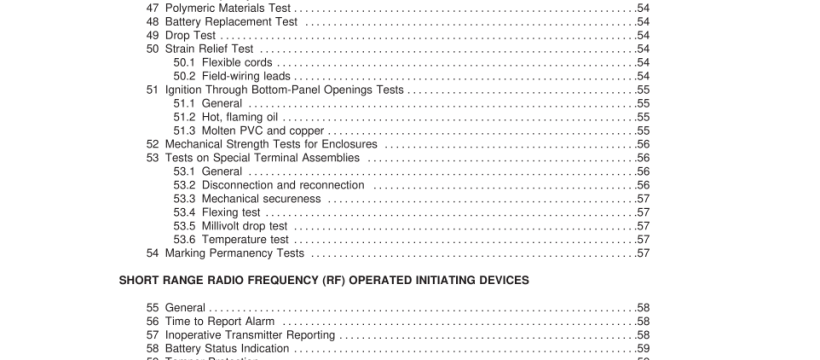UL 636-2010 pdf download.Holdup Alarm Units and Systems.
1 Scope 1 .1 These requirements cover holdup alarm systems of the remote-station type intended for installation in banks, stores, cashiers’ cages, pay offices, and the like to provide a means of transmitting a silent call for help in the event of interior robbery. These systems are divided into the three classes listed in 1 .2 and are defined under Extent of Protection, Section 87. 1 .2 The three classes are: Bandit-Resisting Enclosure and Alarm, Semiautomatic Alarm, and Manual Alarm. 1 .3 A product that contains features, characteristics, components, materials, or systems new or different from those covered by the requirements in this standard, and that involves a risk of fire or of electric shock or injury to persons shall be evaluated using appropriate additional component and end-product requirements to maintain the level of safety as originally anticipated by the intent of this standard. A product whose features, characteristics, components, materials, or systems conflict with specific requirements or provisions of this standard does not comply with this standard. Revision of requirements shall be proposed and adopted in conformance with the methods employed for development, revision, and implementation of this standard. 1 .3 revised March 30, 2001
2.2 Units of measurement 2.2.1 Values stated without parentheses are the requirement. Values in parentheses are explanatory or approximate information. 2.2.1 revised March 30, 2001 2.2.2 Unless otherwise indicated, all voltage and current values mentioned in this standard are rms. 2.3 Undated references 2.3.1 Any undated reference to a code or standard appearing in the requirements of this standard shall be interpreted as referring to the latest edition of that code or standard. 2.4 Terminology 2.4.1 The term ″product″ as used in this standard refers to all types of holdup alarm units. 3 Glossary 3.1 For the purpose of this standard the following definitions apply. 3.2 ALARM INITIATING DEVICE – A switch operated by hand or foot, by key, by removal of currency bills, or by other means to initiate a holdup alarm signal. 3.3 CIRCUITS, ELECTRICAL : a) HIGH-VOLTAGE – A circuit involving a potential of not more than 600 volts and having circuit characteristics in excess of those of a low-voltage power limited circuit. b) LOW-VOLTAGE – A circuit involving a potential of not more than 30 volts AC, rms, 42.4 volts DC or AC peak. c) POWER LIMITED – A circuit whose output is limited as specified in Tables 3.1 and 3.2. The power limitation shall be provided by the construction of the transformer, a fixed impedance, a noninterchangeable fuse, a nonadjustable manual reset circuit protective device, or a regulating network.
7.2 Openings 7.2.1 Openings directly over an uninsulated high-voltage live part shall not exceed 0.1 87 inch (4.75 mm) in any dimension, or shall be of a configuration illustrated by Figure 7.2 for top cover designs and Figure 7.3 for side openings. 7.2.2 An opening that does not permit entrance of a 1 inch (25.4 mm) diameter rod shall be sized and so arranged that a probe, as illustrated in Figure 7.4, cannot be made to contact an uninsulated live electrical part (other than low-voltage) or moving part that may cause injury to persons when inserted through the opening in a straight or articulated position. 7.2.3 An opening that permits entrance of a 1 inch (25.4 mm) diameter round rod is acceptable under the conditions described in Figure 7.5. 7.2.4 Openings may be provided in the bottom panel or pan under an area containing a material not classified V-1 in accordance with the Standard for Tests for Flammability of Plastic Materials for Parts in Devices and Appliances, UL 94, if constructed in a manner that reduces the risk that a material can fall directly from the interior of the product. Figure 7.6 illustrates a type of baffle that complies with this requirement. A second construction that complies with this requirement is a 0.040 inch (1 .02 mm) sheet-steel bottom panel in which 5/64 inch (2.0 mm), or smaller, round holes are spaced no closer together than 1 /8 inch (3.2 mm) center-to-center. Other constructions than these two are acceptable if they comply with the requirements specified in the Ignition Through Bottom-Panel Opening Tests, Section 51 .UL 636-2010 pdf download.
UL 636-2010 pdf download
